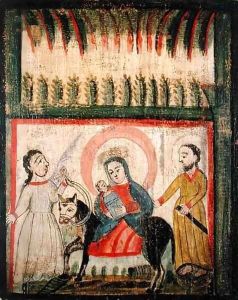Jose Rafael Aragon Paintings
José Rafael Aragón was a notable santero, a maker of religious images, from the Spanish colonial period in what is now the United States. Born around 1795 in the region that would become the state of New Mexico, he became one of the most influential and prolific santeros in New Mexico's history. His birthplace is thought to be in the San Juan Pueblo area, although details about his early life are relatively scarce.
Aragón's work came at a time when New Mexico was an isolated territory, with limited access to European or Mexican ecclesiastical art. As such, local santeros like Aragón created religious art for churches and private individuals. These works, known as 'santos,' were depictions of saints, angels, and other religious figures, and were central to the religious life of the community.
Aragón's style is characterized by its unique blend of local and European artistic traditions. His figures are often depicted with a sense of serene simplicity and an economy of line and color that is distinct from the more elaborate European works of the same period. He was known for his use of natural pigments and for incorporating regional iconography into his pieces, which ranged from small devotional objects to large altar screens known as 'reredoses' or 'retablos.'
Despite the lack of extensive formal records, Aragón's legacy is well established through a significant body of work that survives to this day. His pieces are considered an integral part of New Mexico's cultural heritage and are highly valued both for their artistic merit and for their historical significance as documents of the religious and cultural life of the time.
José Rafael Aragón continued to produce art until his death in 1862. His influence extended beyond his lifetime, as he trained other artists, including his son, who continued the tradition of santero art in New Mexico. Today, Aragón's works are held in various museum collections, studied by art historians, and sought after by collectors of Southwestern art.
